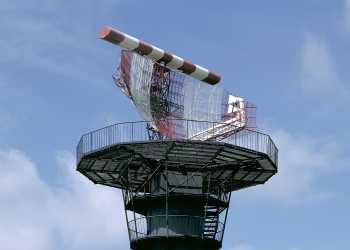Avia-D/Koren
Description of the radar set, tactical-technical characteristics

Figure 1: Former installation in Berlin-Schoenefeld
(52° 21' 2.92" N 13° 32' 14.629" E)
© 1996 DFS Deutsche Flugsicherung, H.-J. Koch

Figure 1: Former installation in Berlin-Schoenefeld
(52° 21' 2.92" N 13° 32' 14.629" E)
© 1996 DFS Deutsche Flugsicherung, H.-J. Koch
| Specifications | |
|---|---|
| frequency: | 1 310 and 1 346 MHz
(L-Band) |
| pulse repetition time (PRT): | |
| pulse repetition frequency (PRF): | ≈1 kHz (5-fold staggered) |
| pulsewidth (τ): | 1.2 µs |
| receive time: | |
| dead time: | |
| peak power: | 800 kW |
| average power: | 900 W |
| instrumented range: | 200 km |
| range resolution: | 300 m |
| accuracy: | 1°; range: 1% of the displays scale |
| beamwidth: | 1.3° |
| hits per scan: | |
| antenna rotation: | 10 or 15 rpm |
| MTBCF: | |
| MTTR: | |
Avia-D/Koren
The Avia-D/Koren was an L-Band En-Route and Air-surveillance radar built in the former Comecon under participation of the former Soviet Union, Eastern Germany and Poland. The primary radar was a frequency diversity radar built by Unitra and PIT (both Poland), the secondary radar “Koren” (Kyrillic: « Корень », meaning: “root”) built in Soviet Union. The scopes and the operators workstations are built in Eastern Germany.
The first installation was in 1976 at the Airport Berlin-Schoenefeld, near the small village Rotberg. A modernization was carried out in 1986. This radar was operational until 1998.
Avia-D consists of four main components; antenna unit, transmitter unit, the receiver unit with the indicators, and the power unit. The antenna set was mounted on a tower of approx. 20 m height. The antenna has a parabolic reflector with dimensions of 12 m · 4 m. The transmitter used two magnetrons for pulsed RF-generation. The accuracy of the measured coordinates was 1 degree in azimuth, and a distance of 1 percent of the the displays maximum scale.[1]
Sources and ressorces:
